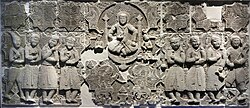
Back Petschenegen ALS Pazinacos AN بجناك Arabic Pechenegos AST Peçeneqlər Azerbaijani پچنقلر AZB Бәшнәктәр Bashkir Petschenegen BAR Печанегі Byelorussian Печенеги Bulgarian
 | |
| Regions with significant populations | |
|---|---|
| Eastern Europe, Anatolia (historical) | |
| Languages | |
| Pecheneg language (historical) | |
| Related ethnic groups | |
| Oghuz Turks and Cumans |
Pecheneg Khanates | |||||||||
|---|---|---|---|---|---|---|---|---|---|
| 889–1091 | |||||||||
 Pecheneg Khanates and neighbouring territories, c.1030 | |||||||||
| Status | Khanate | ||||||||
| Common languages | Pecheneg | ||||||||
| History | |||||||||
• Established | 889 | ||||||||
• Disestablished | 1091 | ||||||||
| |||||||||
| History of the Turkic peoples pre–14th century |
|---|
 |
The Pechenegs (/ˈpɛtʃənɛɡ/) or Patzinaks[note 1] also known as Pecheneg Turks[1] were a semi-nomadic Turkic people from Central Asia who spoke the Pecheneg language. In the 9th and 10th centuries, the Pechenegs controlled much of the steppes of southeast Europe and the Crimean Peninsula. In the 9th century the Pechenegs began a period of wars against Kievan Rus', and for more than two centuries launched raids into the lands of Rus', which sometimes escalated into full-scale wars.
Cite error: There are <ref group=note> tags on this page, but the references will not show without a {{reflist|group=note}} template (see the help page).
- ^ Pritsak 1975, p. 214.